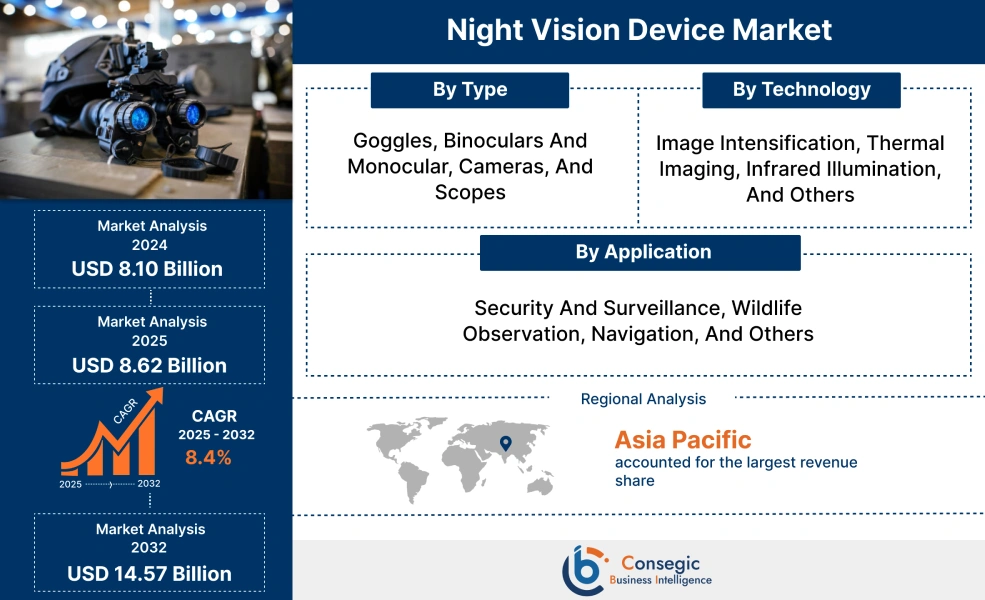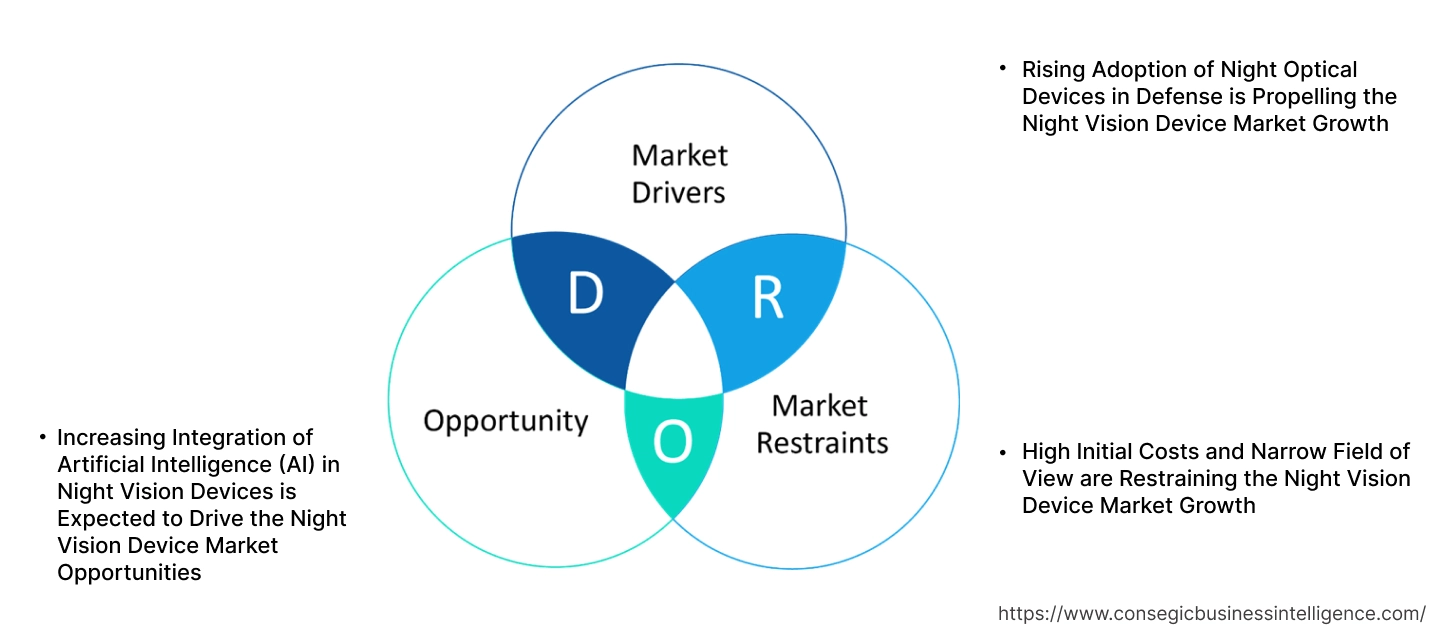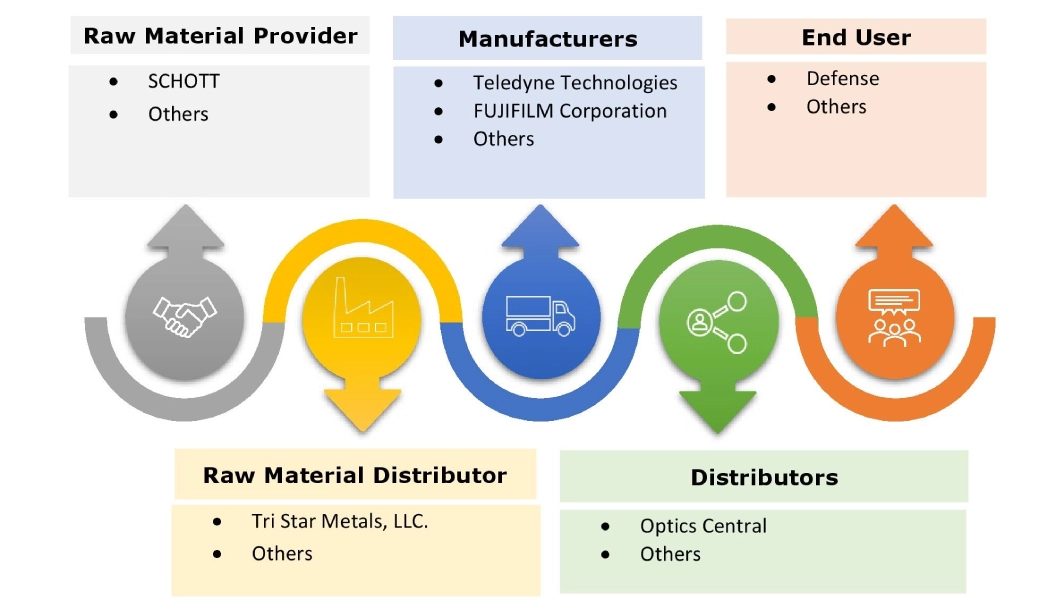Night Vision Device Market Size:
Night Vision Device Market size is estimated to reach over USD 14.57 Billion by 2032 from a value of USD 8.10 Billion in 2024 and is projected to grow by USD 8.62 Billion in 2025, growing at a CAGR of 8.4% from 2025 to 2032.
Night Vision Device Market Scope & Overview:
Night vision device or night optical device refers to a device that signifies the ability to see at night or in a dark place. The devices amplify available light by guiding the light towards an objective lens which then focuses the light onto an image intensifier. Moreover, the rising adoption of the devices due to integration of image intensification, thermal imaging, and CMOS sensors to improve clarity and situational awareness is driving the market.
Night Vision Device Market Dynamics - (DRO) :
Key Drivers:
Rising Adoption of Night Optical Devices in Defense is Propelling the Night Vision Device Market Growth
Night optical devices have experienced a growing adoption in defense sector to enable soldiers to navigate in the dark. Additionally, the devices allow soldiers to detect threats during the night which has driven its adoption. Moreover, the rising investments by governments to source military equipment including night vision goggles and binoculars is driving the market.
- For instance, in March 2023, QinetiQ US announced that the company was awarded a contract worth USD 92.6 million by the U.S. Army for a digital night vision technology contract. QinteiQ aims to invest in digital imaging, display, and processing technologies to support the U.S. army.
Hence, the rising developments in night optical devices in defense to allow soldiers to navigate and detect threats is driving the night vision device market size.
Key Restraints:
High Initial Costs and Narrow Field of View are Restraining the Night Vision Device Market Growth
Night vision binoculars are typically more expensive than traditional binoculars due to the presence of specialized lenses and coatings in the binoculars. Further, the costs are increased due to the presence of four lenses in the goggles and each of the lenses requiring its own image intensifier tube which can be expensive to produce. Moreover, night vision scopes offer a narrow field of view compared to natural vision, which can act as a restraint to the market growth.
Thus, lack of high initial costs and narrow field of view act as a restraint to the night vision device market expansion.
Future Opportunities :
Increasing Integration of Artificial Intelligence (AI) in Night Vision Devices is Expected to Drive the Night Vision Device Market Opportunities
Night optical devices have experienced a rising utilization of artificial intelligence to enhance object recognition. Moreover, the AI can be programmed to detect unusual movements and warn the user in real-time which is driving the market. Additionally, companies have started offering night optical devices that utilize AI to provide steady and uninterrupted visibility, which is driving the overall market.
- For instance, Deepnight offers AI software that leverages CMOS sensors and AI processing to enable better visibility in night vision devices.
Thus, the increasing integration of artificial intelligence (AI) due to enhanced object recognition is projected to drive the night vision device market opportunities during the forecast period.
Night Vision Device Market Segmental Analysis :
By Type:
Based on the type, the market is segmented into goggles, binoculars and monocular, cameras, and scopes.
Trends in the type:
- Increasing adoption of goggles that feature manual gain control to adjust image intensifier gain is driving the night vision device market share.
- Rising utilization of binoculars and monocular for stargazing is driving the night vision device market trends.
Goggles accounted for the largest revenue share of 33.81% in the year 2024.
- In the night optical devices market, goggles have experienced a rising adoption by military and law enforcement personnel which has resulted in the night vision device market expansion.
- Additionally, the goggles have experienced a rising utilization of lighter lenses which is driving the global night vision device market.
- Moreover, the goggles have started featuring powerful batteries that can run for hours which is driving the market.
- For instance, Thales offers BONIE HP night vision goggles that are utilized by special forces. The rise in the number of goggle offerings by manufactures for use in the military is expected to boost the market.
- According to the market analysis, the rising advancements related to goggles due to integration of lighter lenses and powerful batteries are driving the night vision device market trends.
Binoculars and monocular segment is anticipated to register the fastest CAGR during the forecast period.
- Night vision binoculars and monocular have experienced a rising adoption by hikers and campers to navigate trails on a hike.
- Moreover, the rising utilization of the binoculars to monitor suspicious activity around the coast or at airports is driving the market.
- For instance, Fujifilm offers DAY/NIGHT Series binoculars that feature vibration-proofing and night vision for monitoring/conducting safety checks.
- Therefore, the rising adoption of binoculars and monocular due to better monitoring is driving the overall market.
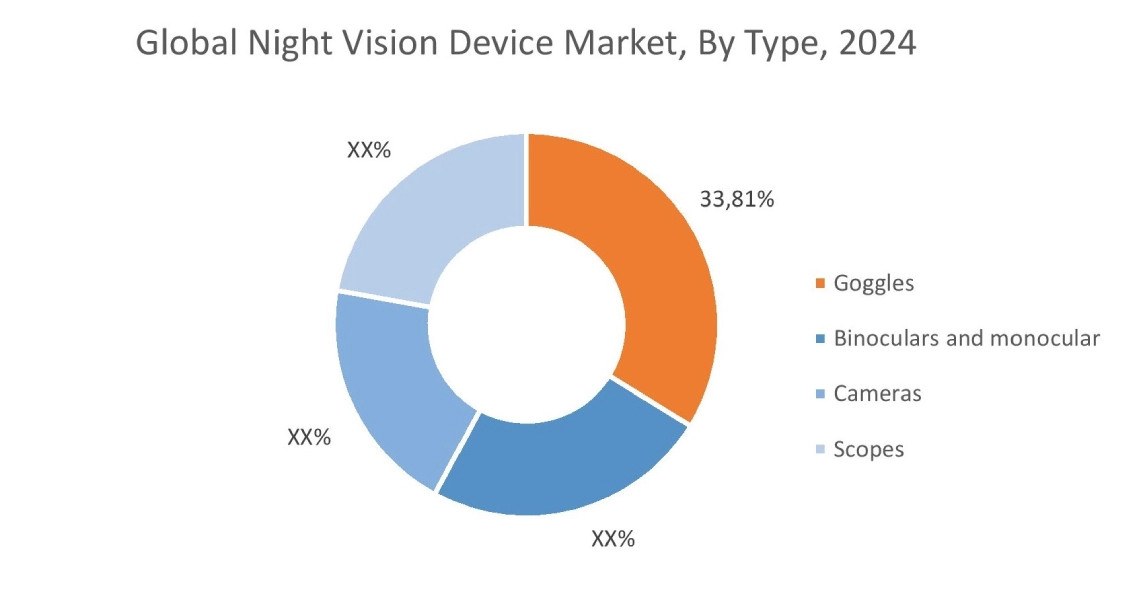
By Application:
Based on the application, the market is segmented into security and surveillance, wildlife observation, navigation, and others.
Trends in the application:
- Rising adoption of night optical devices for security and surveillance due to capturing of better footage during the night is driving the market growth.
- Increasing adoption of night optical devices to observe animals during camping at night is driving the market trends.
Security and surveillance accounted for the largest revenue share in the year 2024.
- Night optical devices have experienced a rising adoption in perimeter security to capture movement around perimeters which has driven the market.
- Moreover, the night vision cameras allow law enforcement professionals to secure an area using colour night vision and audio recording which is driving the growth of the market.
- Additionally, the devices are being increasingly utilized to counter drug operations near borders which is driving the market.
- For instance, Thermoteknix offers NiCam-31 night vision binoculars for police forces, border security, VIP protection. The rise in the adoption of binoculars and cameras for securing an area is driving the market.
- According to the night vision device market analysis, the rising trend in the adoption of night optical devices for security and surveillance to capture movement around perimeters is propelling the night vision device industry during the forecast period.
Wildlife observation is anticipated to register the fastest CAGR during the forecast period.
- Night optical devices namely binoculars and monocular have experienced a growing adoption for wildlife observation to view animals and birds from a distance which has driven the global night vision device market.
- Moreover, the increasing utilization of the night optical devices that feature tough metal parts for improved durability during hikes is driving the market.
- For instance, WILDGUARDER offers night vision binoculars for outdoor activities including wildlife observation and camping. The rise in the adoption of night optical devices for observing nocturnal birds and animals is expected to drive the market.
- Therefore, the increasing demand for night optical devices for wildlife observation to view nocturnal birds and animals is driving the night vision device market size.
By Technology:
Based on the technology, the market is segmented into image intensification, thermal imaging, infrared illumination, and others.
Trends in the technology:
- There has been a rising utilization of thermal imaging due to improved visibility in the presence of fog which is driving the night vision device market demand.
- Increasing adoption of image intensification to amplify natural ambient light from the moon is driving the market trends.
Thermal imaging accounted for the largest revenue share in the year 2024.
- In thermal imaging, infrared energy emitted from objects or persons is converted into a visible thermal image.
- Further, thermal imaging has experienced a rising adoption in surveillance to locate suspects at night.
- Moreover, rising utilization of thermal imaging by firefighters to navigate through smoke is driving the market.
- For instance, Teledyne offers FLIR K1 thermal camera that can be used to navigate in darkness and through smoke. The increasing utilization of thermal imaging cameras by firefighters for navigation during fires is expected to boost the market.
- Therefore, the rising utilization of thermal imaging to locate suspects at night and navigate during fires is driving the overall market.
Image intensification is anticipated to register the fastest CAGR during the forecast period.
- Image intensification utilizes image intensifier tubes that increases the intensity of existing light in an environment.
- Further, the rising utilization of image intensification to get real-time and actionable intelligence is driving the night vision device market demand.
- For instance, AGM offers night vision binoculars called the AGM FoxBat-8 3AL1 for long-range observation using a single high quality image intensifier tube with an image beam splitter.
- Thus, as per the analysis, the rising adoption of image intensification to increase the intensity of existing light is driving the market.
Regional Analysis:
The regions covered are North America, Europe, Asia Pacific, the Middle East and Africa, and Latin America.
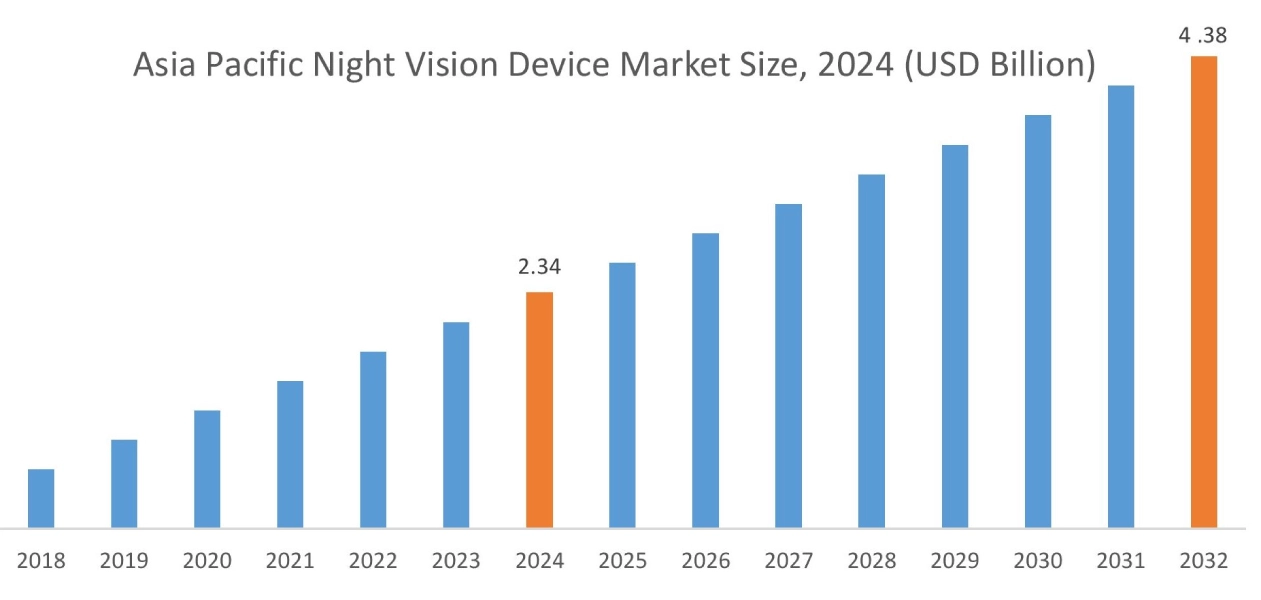
Asia Pacific region was valued at 2.34 Billion in 2024. Moreover, it is projected to grow by 2.50 Billion in 2025 and reach over 4.38 Billion by 2032. Out of this, China accounted for the maximum revenue share of 32.62%. As per the night vision device market analysis, the growth in the Asia-Pacific region is primarily driven by the increasing utilization of night vision binoculars and increasing investments by governments to conserve wildlife sanctuaries.
- For instance, according to the Ministry of Environment, Forest and Climate Change, India has 106 national parks and 573 wildlife sanctuaries. The increasing investments to protect the national parks are expected to boost the market as more people use night vision devices to observe wildlife.
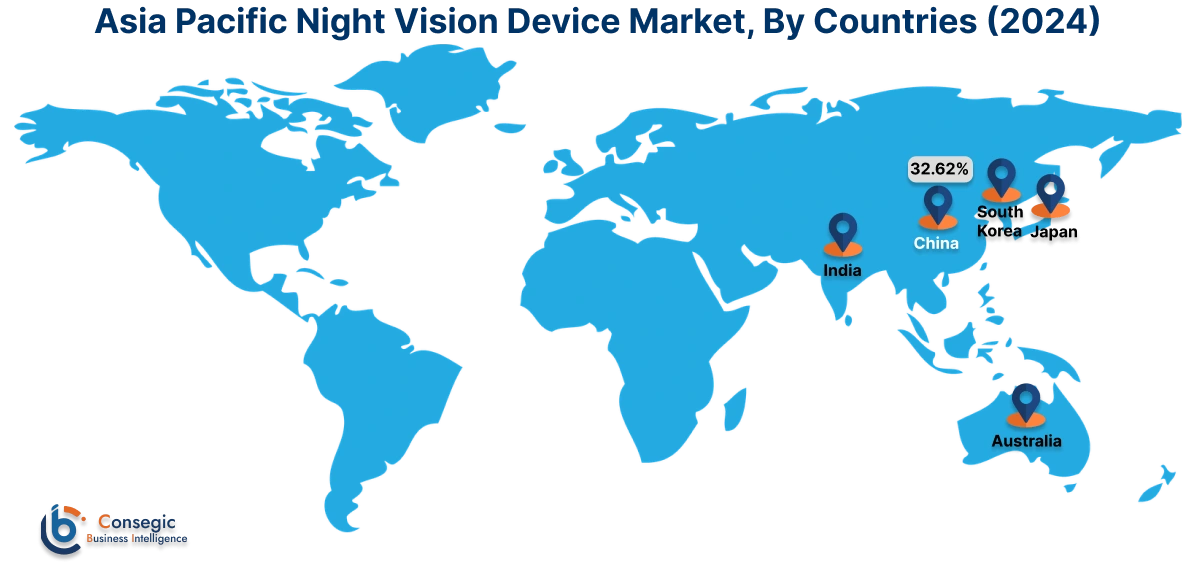
North America is estimated to reach over USD 4.86 Billion by 2032 from a value of USD 2.70 Billion in 2024 and is projected to grow by USD 2.87 Billion in 2025. In North America, the growth of the night vision device industry is driven by the increasing adoption of the devices for security and surveillance. Moreover, the increasing investments by the army and defense companies have resulted in the rise of night vision device market share.
- In January 2025, L3Harris Technologies announced that the company received an order worth USD 263 million from the U.S. Army for continued production of Night Vision Goggles. The rising investments by the army for procurement of night vision goggles are expected to boost the market.
Additionally, the regional analysis depicts that the rising utilization of night optical devices for navigation in marine is driving the market demand in Europe. Furthermore, as per the market analysis, the market demand in Latin America is expected to grow at a considerable rate due to the rising e-commerce sector which has facilitated the buying of night vision goggles. Middle East and African regions are expected to grow at a considerable rate due to factors such as growing income levels and rising investments by law enforcement among others.
Top Key Players and Market Share Insights:
The global night vision device market is highly competitive with major players providing solutions to the national and international markets. Key players are adopting several strategies in research and development (R&D), product innovation, and end-user launches to hold a strong position in the night vision device market. Key players in the night vision device industry include-
- L3Harris Technologies, Inc. (U.S.)
- Tata Advanced Systems Limited (India)
- ATN Corp (U.S.)
- Hangzhou Microimage Software Co., Ltd (China)
- BAE Systems (U.K.)
- Thales (France)
- FUJIFILM Corporation (Japan)
- Bushnell (U.S.)
- Teledyne Technologies (U.S.)
- Yukon Group (Lithuania)
Recent Industry Developments :
Product Launches:
- In March 2025, Thales announced the launch of a panoramic quad-tube night vision goggle that is equipped with four light strengthening tubes. The goggle weighs approximately 700 grams and allows soldiers to perceive their surroundings without any head movement.
Investments and Funding:
- In March 2025, Exosens announced that the company is investing 20 million Euros to grow its production of image intensifier tubes in the U.S. The company aims to expand into the U.S. by opening a production plant in Massachusetts and expects the facility to begin manufacturing in early 2027.
Night Vision Device Market Report Insights :
| Report Attributes | Report Details |
| Study Timeline | 2019-2032 |
| Market Size in 2032 | USD 14.57 Billion |
| CAGR (2025-2032) | 8.4% |
| By Type |
|
| By Technology |
|
| By Application |
|
| By Region |
|
| Key Players |
|
| North America | U.S. Canada Mexico |
| Europe | U.K. Germany France Spain Italy Russia Benelux Rest of Europe |
| APAC | China South Korea Japan India Australia ASEAN Rest of Asia-Pacific |
| Middle East and Africa | GCC Turkey South Africa Rest of MEA |
| LATAM | Brazil Argentina Chile Rest of LATAM |
| Report Coverage |
|
Key Questions Answered in the Report
How big is the night vision device market? +
The night vision device market was valued at USD 8.10 Billion in 2024 and is projected to grow to USD 14.57 Billion by 2032.
Which is the fastest-growing region in the night vision device market? +
Asia-Pacific region is experiencing the most rapid growth in the night vision device market.
What specific segmentation details are covered in the night vision device market report? +
The night vision device market report includes type, technology, application and region.
Who are the major players in the night vision device market? +
The key participants in the night vision device market are L3Harris Technologies, Inc. (U.S.), Thales (France), FUJIFILM Corporation (Japan), Bushnell (U.S.), Teledyne Technologies (U.S.), Yukon Group (Lithuania), Tata Advanced Systems Limited (India), ATN Corp (U.S.), Hangzhou Microimage Software Co., Ltd (China), BAE Systems (U.K.), and Others.
